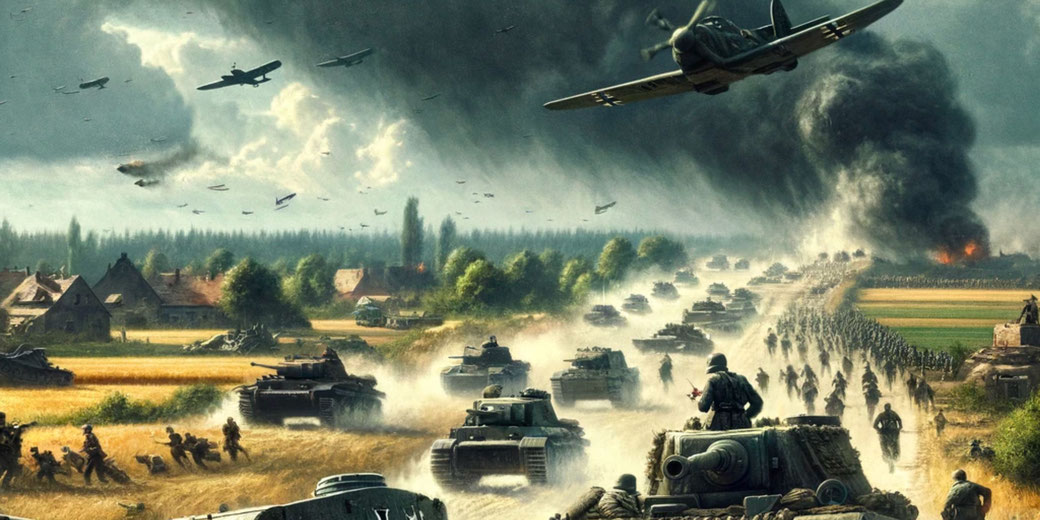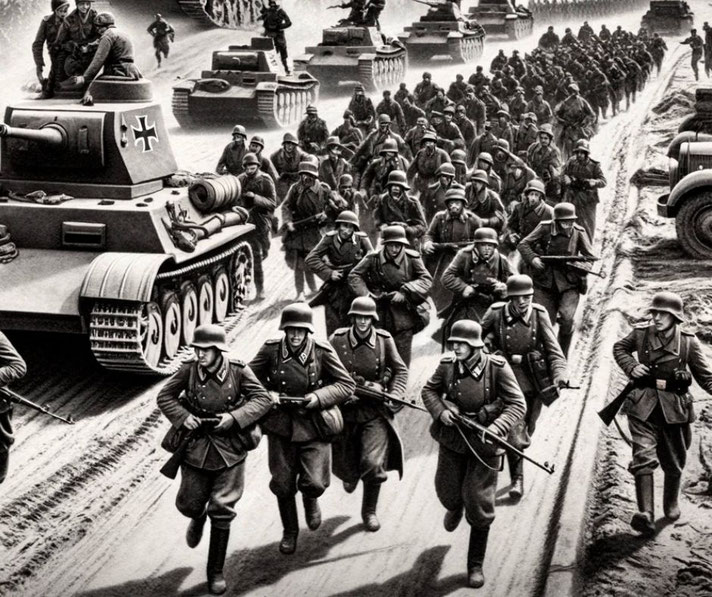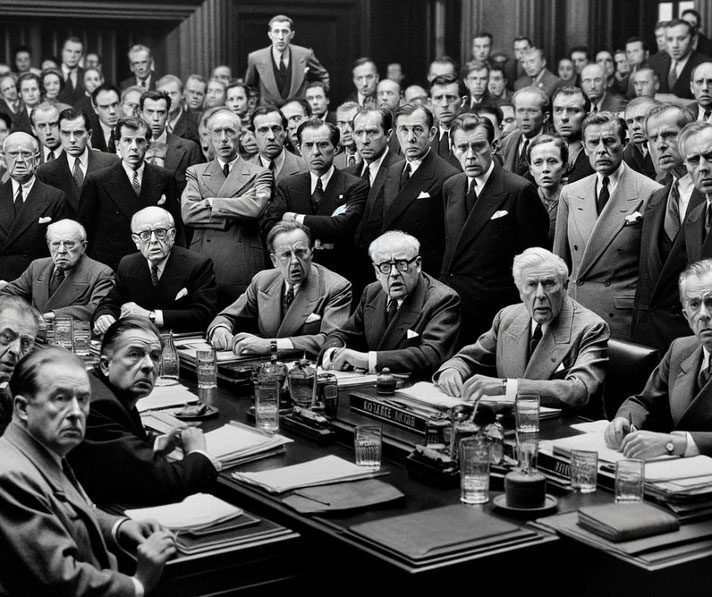What happened when Nazi Germany invaded Poland in September 1939?

On a fateful September morning in 1939, the world awoke to the thunderous echo of Hitler's German tanks rolling across the Polish border.
This sudden military operation introduced the world to the horrifying Blitzkrieg strategy of the new German army and would be the official beginning of World War Two.
But what were the underlying motives driving Hitler's decision to invade Poland?
And how did the international community react to this sudden escalation of aggression?
Germany's aggressive expansion before WWII
The Treaty of Versailles, signed on June 28, 1919, had imposed harsh penalties and territorial losses on Germany.
Over the next ten years, it sowed the seeds of resentment and nationalistic fervor amongst the German people.
In this climate, Adolf Hitler rose to power, becoming Chancellor of Germany in January 1933.
His expansionist ideology and open disdain for the Treaty of Versailles during the 1930s saw Germany's aggressive foreign policy take shape.
Beginning with the reoccupation of the Rhineland in 1936, a direct violation of the Treaty of Versailles and the Locarno Treaties, Hitler began taking back regions that Germany had lost.
Meanwhile, Europe's political landscape was shifting dramatically. The Spanish Civil War, which raged from 1936 to 1939, became a testing ground for Nazi military tactics and equipment, as Hitler became a key ally in the conflict.
In March 1938, Germany annexed Austria in the Anschluss, and in September 1938, the Munich Agreement allowed the annexation of the Sudetenland from Czechoslovakia.
The sudden capitulations to Hitler demonstrated the failed policy of appeasement practiced by Britain and France in the inter-war years.
By March 1939, Germany had then taken military control of the rest of Czechoslovakia.
Soon, the situation in Poland was growing increasingly precarious. The Free City of Danzig (now Gdańsk), a semi-autonomous city-state under the League of Nations, became a focal point of the next stage of German demands.
Hitler's insistence on the return of Danzig to Germany and the establishment of a German-controlled corridor through the Polish Corridor (which separated East Prussia from the rest of Germany) was seen by many to be the next target of Nazi expansion.
Then, in a significant geopolitical maneuver, Nazi Germany and the Soviet Union signed the Molotov-Ribbentrop Pact on August 23, 1939.
This was a non-aggression treaty between the two powers. As they were on either side of Poland, their intention was clear.
This secret agreement included a protocol for the division of Poland and the Baltic States between the two powers, effectively sealing Poland's fate.
Why did Hitler want to invade Poland?
Adolf Hitler was clearly pursuing an aggressive foreign policy aimed at territorial expansion.
Central to his objectives was the notion of Lebensraum, or 'living space', which he believed was essential for the survival and growth of the German people.
This ideology was openly outlined in his book "Mein Kampf," which was published in 1925.
As a result, he situation regarding Poland began to deteriorate rapidly. Hitler's demands for the return of the Free City of Danzig were staunchly refused by Poland.
Poland had received assurances of military support from Britain and France in the event of an invasion.
In fact, the British government, led by Prime Minister Neville Chamberlain, had begun to move away from appeasement.
This is why they were confident in guaranteeing Polish independence in March 1939.
Unfortunately, on August 31, a false flag operation, known as the Gleiwitz incident, was staged by German forces.
It simulating a Polish attack on a German radio station and Hitler declared that it was a real attack.
As a result, this event was used by Nazi propaganda to justify the invasion of Poland.
The invasion begins...
In the early hours of the morning of September 1, 1939, Germany launched an invasion of Poland.
The first target of the invasion was the Polish town of Wieluń, struck by Luftwaffe bombers at 4:40 AM, which was even before the official declaration of war was made.
This was followed by a coordinated attack on the Polish city of Danzig (Gdańsk).
The German battleship Schleswig-Holstein opened fire on the Polish garrison at the Westerplatte peninsula in Danzig.
Simultaneously, German ground forces invaded Poland from the north, south, and west, rapidly advancing into Polish territory.
This assault followed the use of Blitzkrieg, a military strategy that emphasized rapid, surprise attacks with coordinated movements of aircraft, tanks, and infantry.
The Polish army, although determined and valiant, was significantly outmatched.
The German forces utilized their superiority in numbers, equipment, and tactics to encircle and destroy Polish units.
There were a series of major battles occurred at places like the Bzura River and Tuchola Forest, with the Polish forces attempting to regroup and counter the German advancements.
Despite their efforts, the speed and coordination of the German attack left the Polish defense in disarray.
Adding to the complexity of the situation was the Soviet invasion of Poland from the east on September 17, 1939, in accordance with the secret protocol of the Molotov-Ribbentrop Pact.
This move further squeezed the Polish military and civilian population between the two invading forces.
By late September, the Polish government and military leadership had fled to Romania, and Warsaw, enduring a relentless siege, surrendered on September 28.

How the world reacted and the declaration of war
The international response to Germany's invasion of Poland in September 1939 was swift.
The most immediate and significant reactions came from France and the United Kingdom.
On September 3, 1939, just days after the invasion began, both countries declared war on Germany.
This declaration, however, did not immediately lead to significant military action, a period later referred to as the "Phoney War."
The League of Nations, an international organization established after World War I to maintain peace, found itself largely ineffective in the face of aggression.
Despite its purpose, the League lacked the authority and military power to enforce any meaningful sanctions or military response against Germany.
The United States, under President Franklin D. Roosevelt, maintained a position of neutrality.
This was influenced by the prevailing isolationist sentiment in American politics and public opinion.
However, the U.S. did condemn the invasion and began to shift towards a policy of supporting the Allies through material aid.
Other countries, particularly those in Europe, reacted with a mix of apprehension and varying degrees of diplomatic engagement, trying to navigate the rapidly changing geopolitical landscape.
Smaller nations in Eastern Europe, witnessing the fall of Poland, felt a growing sense of vulnerability to the aggressive expansionism displayed by both Germany and the Soviet Union.

What happened to Poland after it was defeated?
The occupation of Poland was brutal. Germany and the Soviet Union, following the terms of the Molotov-Ribbentrop Pact, divided Poland between them.
The German-occupied western and central parts of Poland were subjected to harsh rule.
German policy aimed at the direct incorporation of former Polish territories into the Reich involved the systematic persecution and extermination of the Polish intellectual and cultural elite: an effort to destroy Poland's identity and subjugate its people.
As a result, thousands of politicians, academics, and artists were arrested and executed or sent to concentration camps.
The Jewish population in Poland, which was one of the largest in Europe, faced unimaginable horrors.
The Nazis began the systematic persecution and annihilation of the Jewish people, which later escalated into the Holocaust.
Ghettos were established in major cities like Warsaw and Krakow, where Jews were confined under deplorable conditions before being transported to extermination camps.
The Soviet occupation of eastern Poland was also followed by atrocities, including the Katyn massacre in April and May 1940.
There were approximately 22,000 Polish military officers and intelligentsia executed.
The Soviets also sought to suppress Polish culture and identity in their occupied zone.
What do you need help with?
Download ready-to-use digital learning resources
Copyright © History Skills 2014-2024.
Contact via email
With the exception of links to external sites, some historical sources and extracts from specific publications, all content on this website is copyrighted by History Skills. This content may not be copied, republished or redistributed without written permission from the website creator. Please use the Contact page to obtain relevant permission.





